North America Occupancy Sensors Market Size
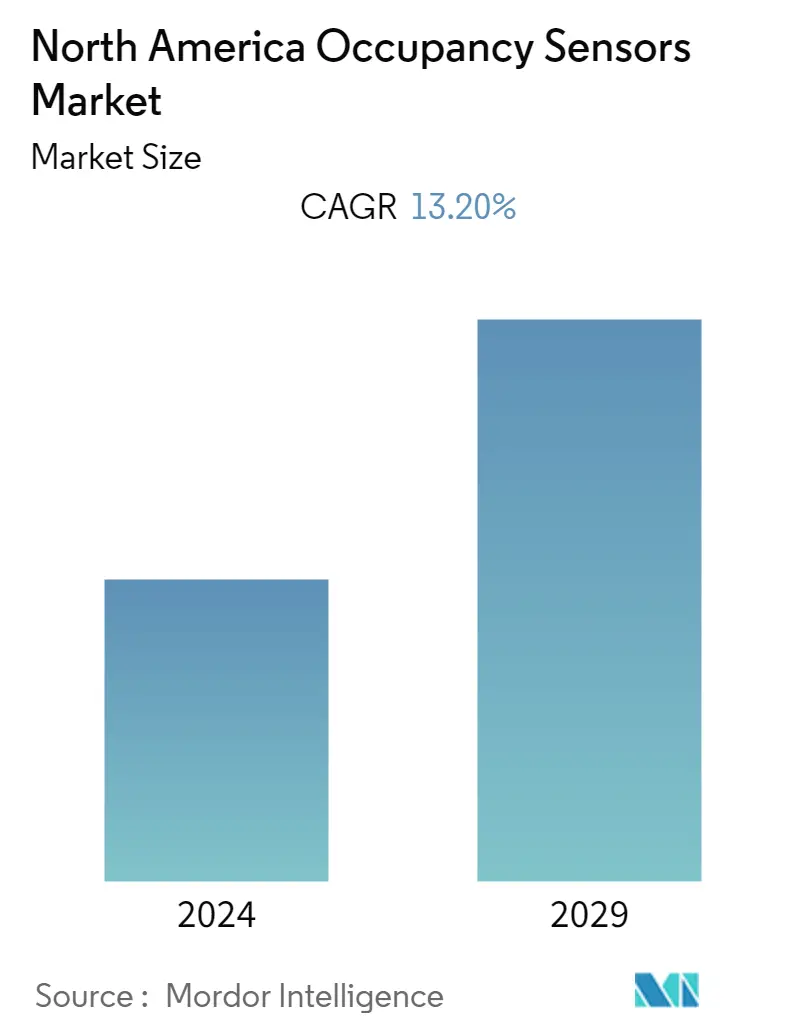
| Study Period | 2019 - 2029 |
| Base Year For Estimation | 2023 |
| Forecast Data Period | 2024 - 2029 |
| Historical Data Period | 2019 - 2022 |
| CAGR | 13.20 % |
| Market Concentration | Low |
Major Players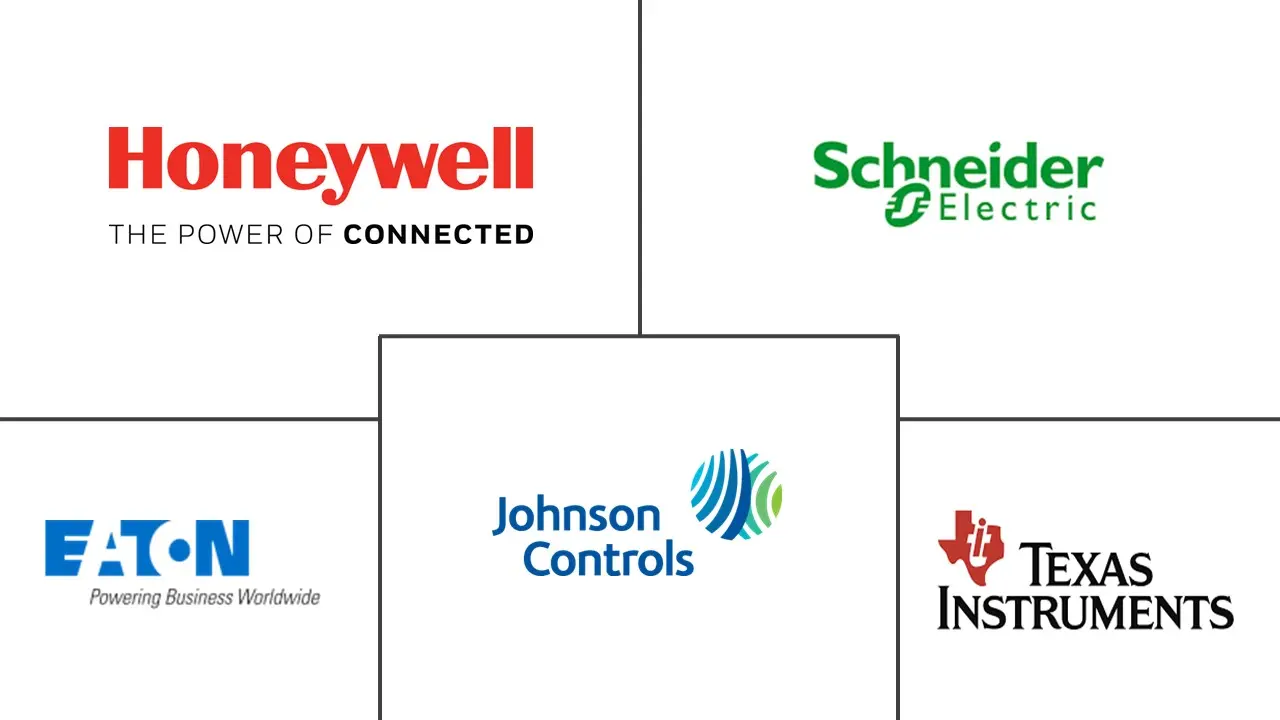
*Disclaimer: Major Players sorted in no particular order |
North America Occupancy Sensors Market Analysis
The North American Occupancy Sensors Market is expected to reach a CAGR of 13.2% during the forecast period (2020 - 2025). North America is the largest market for occupancy sensors, with the United States leading the market followed by Canada. The growth in the construction industry, especially in the private sector is one of the primary drivers for the market in this geographical region.
- In August 2019, Edwards Vacuum opened its energy-efficient, semiconductor technology center in North America. The building is designed with advanced occupancy sensors and is thus considered eco-friendly. Many other facilities are also expected to utilize occupancy sensors in their upcoming construction.
- Another major driving factor for market expansion is a higher focus on innovation and advancements in occupancy sensors such as image processing occupancy sensor (IPOS), intelligent occupancy sensor (IOS), and micro-phonics. In May 2019, Panasonic (North America) introduced "Low Profile" Type PIR Motion Sensors offering a 10.9 mm profile alternative, which are widely used in HVAC systems, smart home and surveillance systems.
- Presence of major vendors and their new offerings are also contributing to market growth. For instance, in March 2019, Texas-based Asure Software launched workplace IoT occupancy sensors which is built upon SmartView solution. It is a fully automated and integrated space utilization measurement system that provides real-time insights for businesses to understand and optimize available real estate and workstations.
- However, there has been recent incidents where there has been failure by the occupancy sensors to detect motion, which is challenging the market growth. In August 2019, Volkswagen Group of America recalled 144,092 Audi vehicles in the U.S. to fix malfunctioning passenger-side airbag occupant sensors. Due to oxidation of the connecting cable, the airbags did not open even after warning notification, which put the passenger's life at risk.
- The recent outbreak of the Coronavirus is expected to influence the occupancy sensor market significantly due to the complete lockdown of manufacturing facilities and consumer markets. The influence of Corona Virus outbreak is expected to influence the electronics manufacturers significantly and currently they are facing raw material supply shortages along with significant decrease from prominent demand industries such as consumer electronics and automotive, this is expected to continue till the end of 2020 and recover by 2021. According to IPC's survey of electronics businesses, around 69% of the respondents are being told by their suppliers that there will be delays in shipments due to COVID-19.
North America Occupancy Sensors Market Trends
This section covers the major market trends shaping the North America Occupancy Sensors Market according to our research experts:
Residential Segment is Expected to Witness Significant Growth
- Following a period of stagnation over the duration of 2010-2016, the number of owner-occupied housing units in the United States has recently started growing again, increasing to 80.68 million in 2019.(US Department of Housing and Urban Development Estimates). This is because the house prices have been rising faster than the cost of rent, meaning that it is increasingly more affordable to own a house than to rent. Hence the owners are keen to adopt smart lighting solutions to save on energy costs.
- According to the U.S. Energy Information Administration (EIA), residential sector electricity consumption for lighting was about 75 billion kWh or about 5% of total residential sector electricity consumption in 2019.
- Smart Home adoption is also on the rise in the US. In a survey conducted online in Q4 2019 of 5,000 people across the US, by SmartEnergy IP, a division of SmartMark Communications, it was concluded that the “cool factor” was a major driver surrounding smart home investments, with nearly 37% of respondents citing it as a reason for their interest in smart home devices. These statistics suggests a transition in original thinking and marketing of smart home products. The survey also included questions around product preferences, with smart thermostats, smart security and smart lighting, gathering most votes.
- Partnerships and entry by global players into the North America market are also expected to shape the market landscape in future. Recently, Austria-based Loxone entered the US market in February 2019 with their smart home automation control offering that features more than 150 SKUs of products, including occupancy sensors, as well as temperature and humidity sensors.
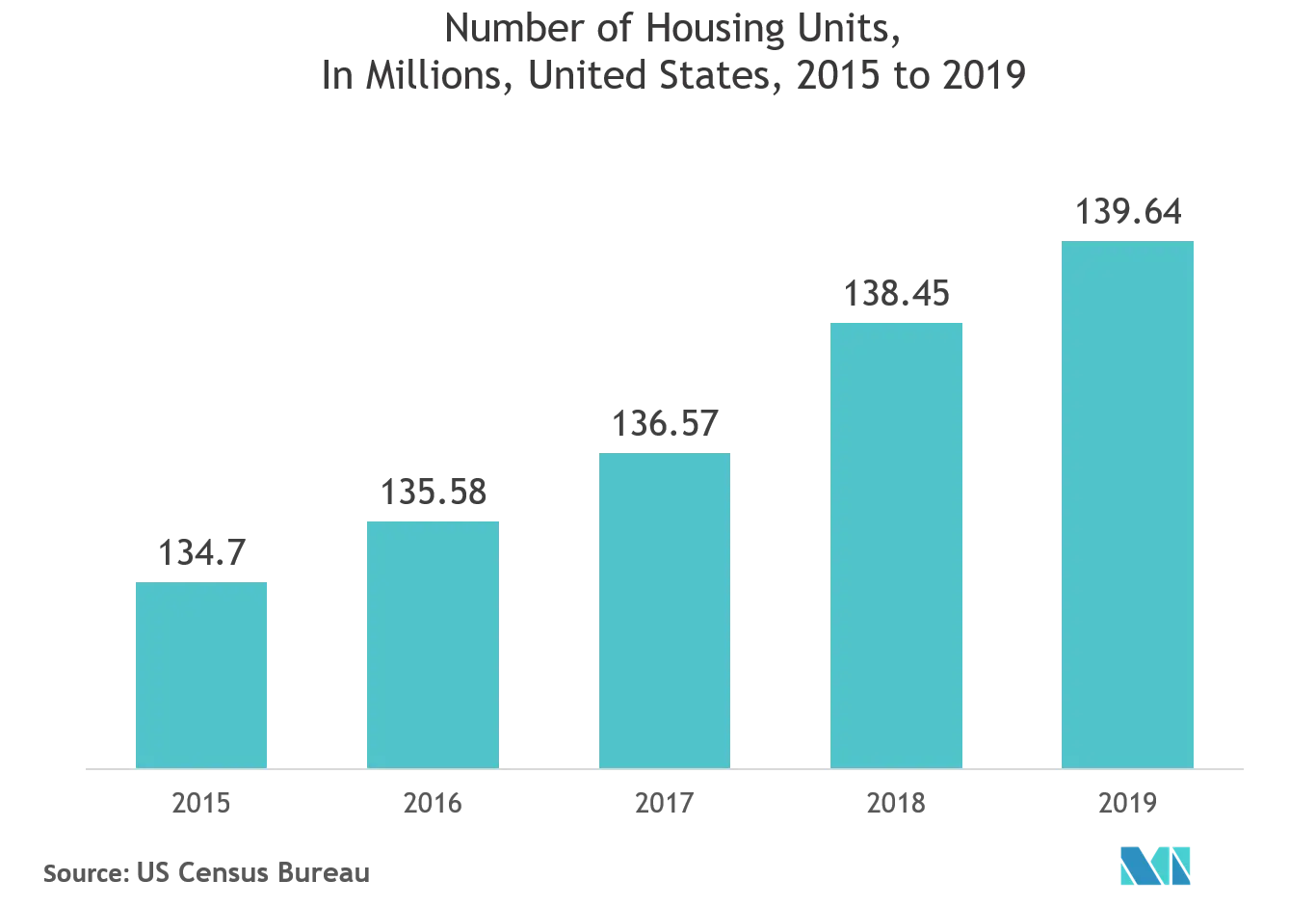
HVAC Segment is Expected to Witness Significant Growth
- The demand for air conditioning in the commercial industry is growing in the country. In February 2019, Comfort Systems USA – a prominent provider of mechanical services, including heating, ventilation, air conditioning (HVAC), plumbing, piping, and controls – announced that it has entered into a definitive agreement to acquire Walker TX Holding Company Inc. and its related subsidiaries headquartered in Texas. In addition, government regulations about energy efficiency and the use of environment-friendly refrigerants are expected to create opportunities for the market over the forecast period.
- The region is focusing on smart city development to improve energy efficiency. The city of Newark, New Jersey has onboarded Honeywell install energy-efficient control solutions that incorporate the city’s HVAC, like room occupancy sensors, and multi-location control of building systems. This is a part of the city’s Sustainability Action Plan. Initiatives such as these are expected to deliver significant savings in energy operations and hence drive exponential market demand.
- Moreover, according to a forecast from the American Institute of Architect, construction spending was expected to grow through 2019. Based on short-term projections, the US non-residential construction market is anticipated to grow to 2.4% in 2020, compared to the previous year. According to the US Census Bureau, the value of construction starts in the United States is estimated to reach USD 135 billion in 2022. At the beginning of 2019, private offices were the most common types of commercial construction to start in the country.
- Many vendors are introducing advanced products for commercial applications. For instance, in June 2019, Mitsubishi Electric Trane HVAC US (METUS) announced the launch of its line of MSZ/MUZ-WR Model 16 Seasonal Energy Efficiency Ratio (SEER) heat pumps. These new heat pumps are part of the M-Series product line, including outdoor units, indoor units, and controller options for light commercial applications. With rated capacities of 9, 12, 18, and 24 kBtu/h, the 4 WR Model heat pumps’ efficiencies can reach up to 16 SEER.
- Additionally, at the 2019 AHR Expo in Atlanta, Samsung HVAC North America announced that it would expand its commercial air conditioning business in the region by building, training, and supporting a network of specifying representatives, distributors, and installers. The company also announced it is expanding its Wind-free advanced cooling models for light commercial solutions. The surge in the demand of HVACs is expected to drive the growth of occupancy sensors in the region.
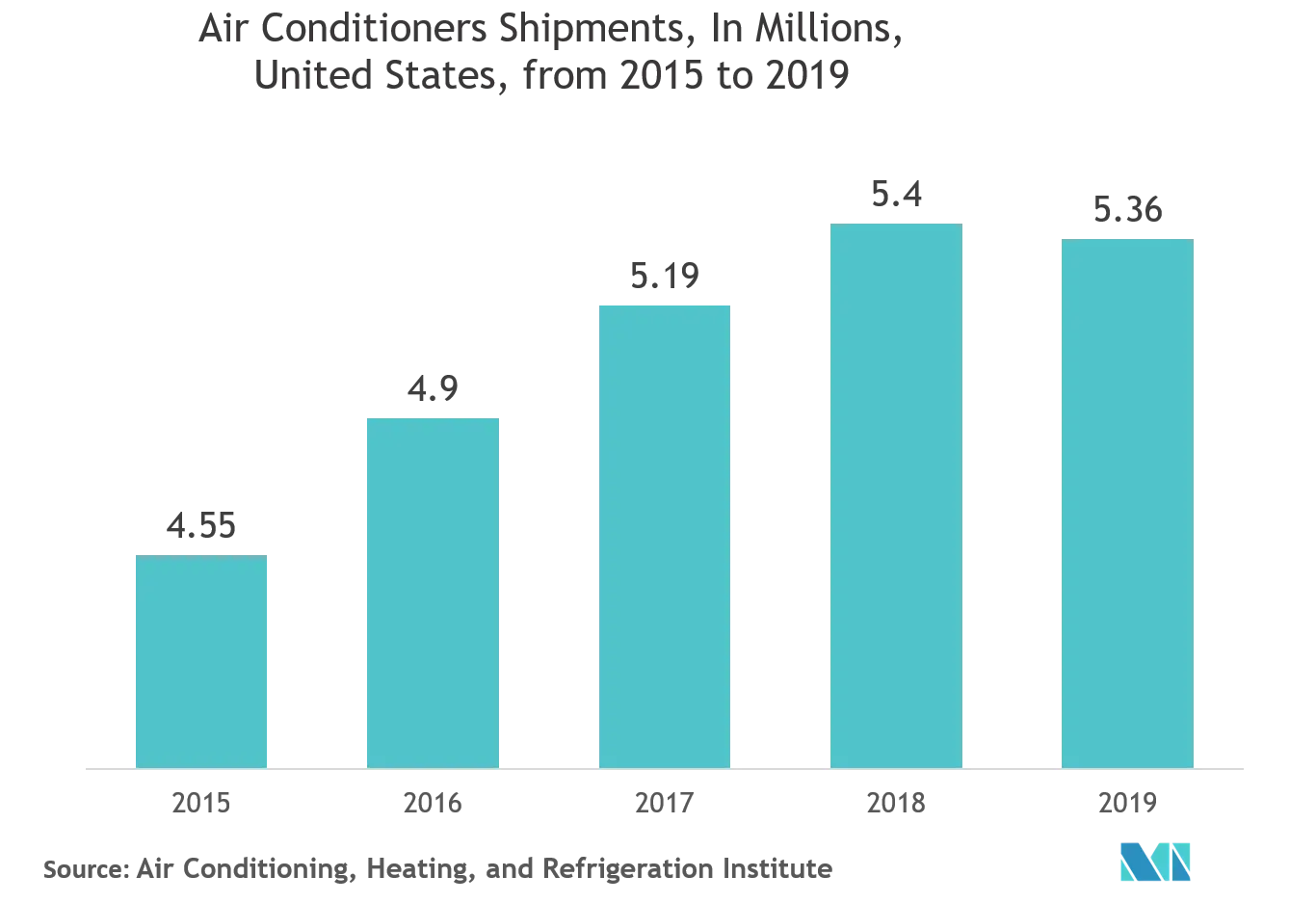
North America Occupancy Sensors Industry Overview
The occupancy sensors market is highly competitive and consists of numerous major players. In terms of market share, few major players currently dominate the market. These major players with a prominent share in the market are focusing on expanding their customer base across international countries. Additionally, these companies are continuously innovating their products to increase their market share and increase their profitability.
- September 2019 - US-based McWong International and Finland-based Casambi Technologies collaborated to introduce a comprehensive control platform that consists of a wide range of control devices, such as dimming occupancy sensors (PIR, ultrasonic, and microwave).
- August 2019 - At CES 2019 in Las Vegas, EnOcean launched a new ceiling-mounted solar-powered occupancy sensor for Bluetooth lighting control systems communicating via Bluetooth Low Energy (BLE). It is the first self-powered Bluetooth occupancy sensor in the market. Such innovations are forecasted to meet the growing market demand for occupancy sensors which leverages lighting systems as data grid for smart building services.
North America Occupancy Sensors Market Leaders
-
Schneider Electric SE
-
Eaton Corp PLC
-
Honeywell Inc
-
Johnson Controls Inc
-
Texas Instruments Inc.
*Disclaimer: Major Players sorted in no particular order
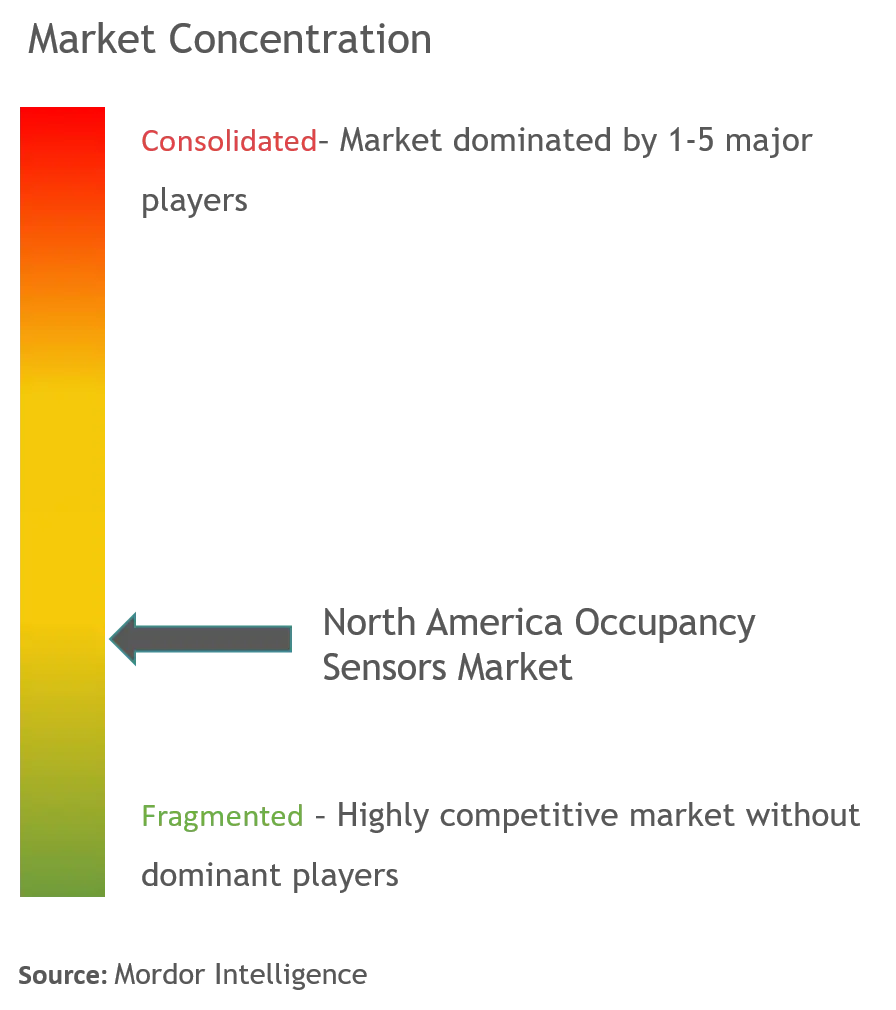
North America Occupancy Sensors Market Report - Table of Contents
1. INTRODUCTION
- 1.1 Study Assumptions and Market Definition
- 1.2 Scope of the Study
2. RESEARCH METHODOLOGY
3. EXECUTIVE SUMMARY
4. MARKET DYNAMICS
- 4.1 Market Overview
-
4.2 Industry Attractiveness - Porter's Five Forces Analysis
- 4.2.1 Bargaining Power of Suppliers
- 4.2.2 Bargaining Power of Buyers
- 4.2.3 Threat of New Entrants
- 4.2.4 Intensity of Competitive Rivalry
- 4.2.5 Threat of Substitute Products
- 4.3 Industry Value Chain Analysis
- 4.4 Impact of COVID-19 on the Industry
-
4.5 Market Drivers
- 4.5.1 Rising demand for energy-efficient devices
-
4.6 Market Challenges
- 4.6.1 False triggering of switch
5. MARKET SEGMENTATION
-
5.1 Network Type
- 5.1.1 Wired
- 5.1.2 Wireless
-
5.2 Technology
- 5.2.1 Ultrasonic
- 5.2.2 Passive Infrared
- 5.2.3 Microwave
-
5.3 Application
- 5.3.1 Lighting Control
- 5.3.2 HVAC
- 5.3.3 Security & Surveillance
-
5.4 Building Type
- 5.4.1 Residential
- 5.4.2 Commercial
-
5.5 Country
- 5.5.1 United States
- 5.5.2 Canada
6. COMPETITIVE INTELLIGENCE
-
6.1 Company Profiles
- 6.1.1 Schneider Electric SE
- 6.1.2 Eaton Corp PLC
- 6.1.3 Signify Holding BV
- 6.1.4 Honeywell Inc
- 6.1.5 Dwyer Instruments Inc.
- 6.1.6 Johnson Controls Inc
- 6.1.7 General Electric Co
- 6.1.8 Legrand SA
- 6.1.9 Analog Devices Inc
- 6.1.10 Texas Instruments Inc
- *List Not Exhaustive
7. INVESTMENT ANALYSIS
8. FUTURE OF THE MARKET
** Subject To AvailablityNorth America Occupancy Sensors Industry Segmentation
The study characterizes the occupancy sensors market based on the type of network, technology, Application, Building Type, and Country. The occupancy sensor is used to save energy, comply with building codes, provide automatic control, and various other such applications. One of the most-used technologies among the occupancy sensors is the passive infrared, which detects occupancy within a specific field and activates lighting and is extremely useful in small spaces. Moreover, the advent of advanced occupancy sensors, such as micro-phonics, intelligent occupancy sensors, image processing occupancy sensors, and the new vision-based intelligent occupancy sensor for HVAC systems are fuelling the growth of the occupancy sensor market.
| Network Type | Wired |
| Wireless | |
| Technology | Ultrasonic |
| Passive Infrared | |
| Microwave | |
| Application | Lighting Control |
| HVAC | |
| Security & Surveillance | |
| Building Type | Residential |
| Commercial | |
| Country | United States |
| Canada |
North America Occupancy Sensors Market Research FAQs
What is the current North America Occupancy Sensors Market size?
The North America Occupancy Sensors Market is projected to register a CAGR of 13.20% during the forecast period (2024-2029)
Who are the key players in North America Occupancy Sensors Market?
Schneider Electric SE, Eaton Corp PLC, Honeywell Inc, Johnson Controls Inc and Texas Instruments Inc. are the major companies operating in the North America Occupancy Sensors Market.
What years does this North America Occupancy Sensors Market cover?
The report covers the North America Occupancy Sensors Market historical market size for years: 2019, 2020, 2021, 2022 and 2023. The report also forecasts the North America Occupancy Sensors Market size for years: 2024, 2025, 2026, 2027, 2028 and 2029.
North America Occupancy Sensors Industry Report
Statistics for the 2024 North America Occupancy Sensors market share, size and revenue growth rate, created by Mordor Intelligence™ Industry Reports. North America Occupancy Sensors analysis includes a market forecast outlook to 2029 and historical overview. Get a sample of this industry analysis as a free report PDF download.



